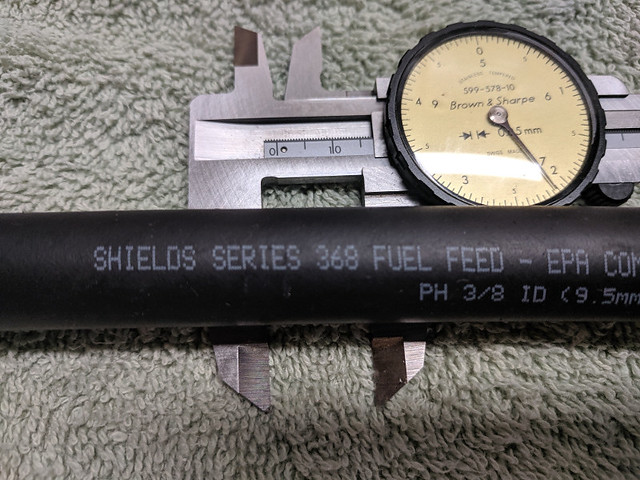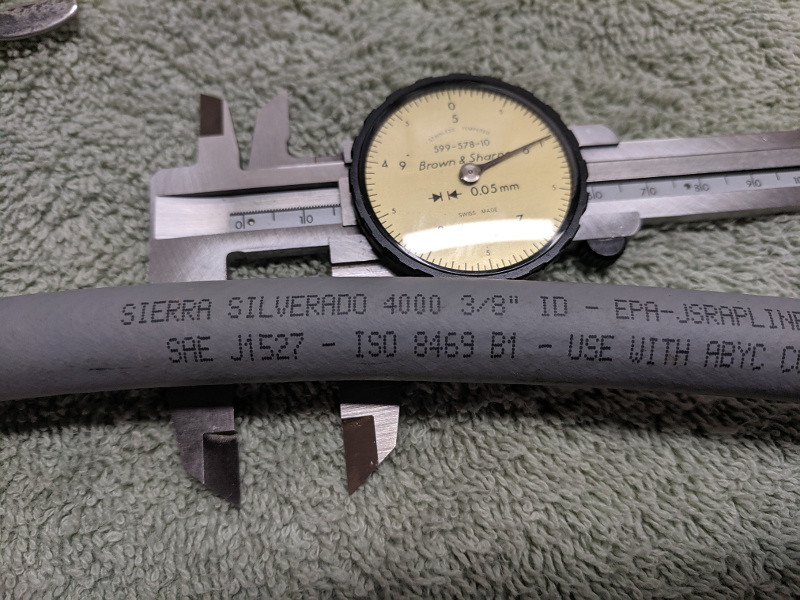Modern Gray Fuel Hose: friend or foe?
Posted: Fri Jun 28, 2019 10:20 am
There's certainly been plenty written about the evils of gray fuel line, how it disintegrates, and how it causes all sorts of problems. Some say that's still the case, while others contend that modern gray fuel line doesn't have these problems. Here's a look from my own experience with my 2003 160 Dauntless, which has a 45-gallon internal tank and a below-deck canister fuel filter.
Every year I replace my primer bulb with an OEM Mercury replacement. About every five years I also replace the fuel line from the primer bulb into the engine. Finally, every eight years—when I'm in the mood for a particularly difficult job and have an urge to get covered in gasoline—I replace the entire fuel line from the tank through the below-deck canister filter to the engine.
This year I had that urge.
For the fuel line from the tank to the canister filter and from there to the primer bulb I have always used Shields Series 368 3/8" ID hose. This is a heavy-weight, thick-walled hose that's not particularly flexible but it has always stood up very well to use including 10% ethanol fuel. It has a thick rubber wall with nylon reinforcement and a very thin inner liner. The inner liner has never shown any sign of degradation or delamination, and while the photos below are of a new piece of fuel line, the 8-year-old fuel line looked exactly the same. I think it could go for years and years with no problems.

Fig. 1. Shields Series 338 fuel line (new).

Fig. 2. Shields Series 338 fuel line end (new). Note the nylon reinforcement embedded in the rubber and the thin inner liner.

Fig. 3. Shields Series 338 fuel line section (new). The inner liner seems strongly bonded to the outer hose.
Unfortunately the Series 338 fuel line has an OD of about 17mm or 11/16", which is too large to pass through the rubber grommet into the engine. So from the primer bulb to the engine I have in the past used Sierra Silverado 3000 3/8" ID fuel line, which is termed "above deck" fuel line by the manufacturer. Silverado 3000 has a shiny gray outer later and much thinner walls than Series 338 with an OD of about 13.5mm or 17/32", making it much more flexible. In fact it will kink if you're not careful about the run. The fuel line has no visible nylon or other reinforcement, but it does have a fairly thick clear plastic inner layer. This year when I disconnected the line from the primer bulb, I found that about 1/4" of the inner liner had delaminated from the outer hose and was pushed up into the fuel line, mostly blocking it. It's a testament to the Mercury 115 EFI four-stroke's stingy use of fuel that it was able to run happily with such a restricted fuel flow. Unfortunately I threw that section of hose away before I thought to write this article, so I don't have a photo of it. The liner did remain in one piece however, and there were absolutely no fragments or plastic goo in the on-engine fuel filter bowl. Still I have to conclude that this is pretty terrible stuff and should certainly be avoided. Silverado 3000 -- definitely FOE.

Fig. 4. Shields Silverado 3000 fuel line (about 5 years of use). Note the glossy outer surface.

Fig. 5. Shields Silverado 3000 fuel line end (about 5 years of use). Simply cutting through the fuel line was enough to start the liner peeling from the outer tubing.

Fig. 6. Shields Silverado 3000 fuel line section (about 5 years of use). The inner liner eagerly peels away from the hose.
This year I was able to get some different "above deck" fuel line, Shields Silverado 4000, also in 3/8" ID. This hose has a matte gray finish and is easily distinguished from Silverado 3000. It is slightly thicker with an OD of about 16mm or 5/8". While that's not a lot narrower than the Series 338, it still fits through the hole in the outboard grommet. Silverado 4000 is much more flexible than Series 338, but not so flexible or prone to kinks as Silverado 3000.

Fig. 7. Shields Silverado 4000 (new). Note the matte surface. Lighting conditions make the hose look darker than it really is.

Fig. 8. Shields Silverado 4000 end (new). Note the thick black rubber liner that is interlocked with the outer hose using jigsaw-puzzle-like protrusions.

Fig. 9. Shields Silverado 4000 section (new). It appears that the interlocking protrusions between the liner and the outer hose are both radial and lengthwise. I don't think that inner liner will be separating any time soon.
Of course, I'm just installing the this new fuel line now, so I won't know for a few years yet how it holds up, but it does look like a substantial improvement over the previous version. Silverado 4000 -- maybe friend?
-Bob
Every year I replace my primer bulb with an OEM Mercury replacement. About every five years I also replace the fuel line from the primer bulb into the engine. Finally, every eight years—when I'm in the mood for a particularly difficult job and have an urge to get covered in gasoline—I replace the entire fuel line from the tank through the below-deck canister filter to the engine.
This year I had that urge.
For the fuel line from the tank to the canister filter and from there to the primer bulb I have always used Shields Series 368 3/8" ID hose. This is a heavy-weight, thick-walled hose that's not particularly flexible but it has always stood up very well to use including 10% ethanol fuel. It has a thick rubber wall with nylon reinforcement and a very thin inner liner. The inner liner has never shown any sign of degradation or delamination, and while the photos below are of a new piece of fuel line, the 8-year-old fuel line looked exactly the same. I think it could go for years and years with no problems.

Fig. 1. Shields Series 338 fuel line (new).

Fig. 2. Shields Series 338 fuel line end (new). Note the nylon reinforcement embedded in the rubber and the thin inner liner.

Fig. 3. Shields Series 338 fuel line section (new). The inner liner seems strongly bonded to the outer hose.
Unfortunately the Series 338 fuel line has an OD of about 17mm or 11/16", which is too large to pass through the rubber grommet into the engine. So from the primer bulb to the engine I have in the past used Sierra Silverado 3000 3/8" ID fuel line, which is termed "above deck" fuel line by the manufacturer. Silverado 3000 has a shiny gray outer later and much thinner walls than Series 338 with an OD of about 13.5mm or 17/32", making it much more flexible. In fact it will kink if you're not careful about the run. The fuel line has no visible nylon or other reinforcement, but it does have a fairly thick clear plastic inner layer. This year when I disconnected the line from the primer bulb, I found that about 1/4" of the inner liner had delaminated from the outer hose and was pushed up into the fuel line, mostly blocking it. It's a testament to the Mercury 115 EFI four-stroke's stingy use of fuel that it was able to run happily with such a restricted fuel flow. Unfortunately I threw that section of hose away before I thought to write this article, so I don't have a photo of it. The liner did remain in one piece however, and there were absolutely no fragments or plastic goo in the on-engine fuel filter bowl. Still I have to conclude that this is pretty terrible stuff and should certainly be avoided. Silverado 3000 -- definitely FOE.

Fig. 4. Shields Silverado 3000 fuel line (about 5 years of use). Note the glossy outer surface.

Fig. 5. Shields Silverado 3000 fuel line end (about 5 years of use). Simply cutting through the fuel line was enough to start the liner peeling from the outer tubing.

Fig. 6. Shields Silverado 3000 fuel line section (about 5 years of use). The inner liner eagerly peels away from the hose.
This year I was able to get some different "above deck" fuel line, Shields Silverado 4000, also in 3/8" ID. This hose has a matte gray finish and is easily distinguished from Silverado 3000. It is slightly thicker with an OD of about 16mm or 5/8". While that's not a lot narrower than the Series 338, it still fits through the hole in the outboard grommet. Silverado 4000 is much more flexible than Series 338, but not so flexible or prone to kinks as Silverado 3000.

Fig. 7. Shields Silverado 4000 (new). Note the matte surface. Lighting conditions make the hose look darker than it really is.

Fig. 8. Shields Silverado 4000 end (new). Note the thick black rubber liner that is interlocked with the outer hose using jigsaw-puzzle-like protrusions.

Fig. 9. Shields Silverado 4000 section (new). It appears that the interlocking protrusions between the liner and the outer hose are both radial and lengthwise. I don't think that inner liner will be separating any time soon.
Of course, I'm just installing the this new fuel line now, so I won't know for a few years yet how it holds up, but it does look like a substantial improvement over the previous version. Silverado 4000 -- maybe friend?
-Bob